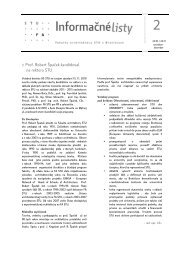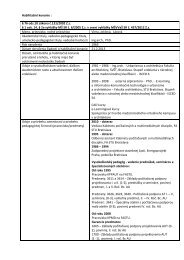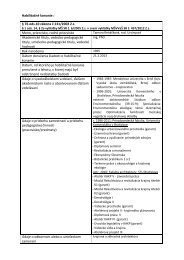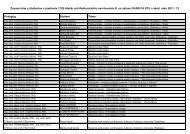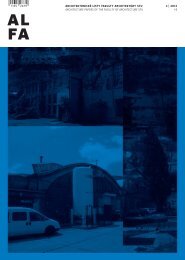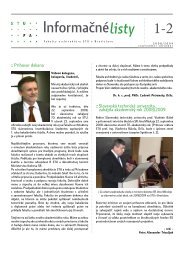ALFA 3-4/2005 - Fakulta architektúry STU
ALFA 3-4/2005 - Fakulta architektúry STU
ALFA 3-4/2005 - Fakulta architektúry STU
Create successful ePaper yourself
Turn your PDF publications into a flip-book with our unique Google optimized e-Paper software.
Ročník 9<br />
3-4 / <strong>2005</strong> ARCHITEKTONICKÉ LISTY FA <strong>STU</strong><br />
• Adaptable single-bed rooms should be provided in almost all<br />
situations. Based on an extremely large and varied body of<br />
research there can be no doupt that single-bed rooms have<br />
numerous major advantages over multi-bed rooms.<br />
• New hospitals should be much quieter to reduce stress and<br />
improve sleep and other outcomes. Noise levels should be<br />
substantially lowered.<br />
• Provide patients stress reducing views of nature and other<br />
positive distractions.<br />
• Develop way-finding systems that allow users, d particularly<br />
outpatients and visitors, to find their way efficiently and with little<br />
stress.<br />
• Improve ventilation through the use of improved filters, attention<br />
to appropriate pressurization, and special vigilance during<br />
construction.<br />
• Improve lighting, especially access to natural lighting and fullspectrum<br />
lighting.<br />
• Design ward layouts and nurses stations to reduce staff walking<br />
and fatigue, increase patient care time, and support staff activities<br />
such as medication supply, communication, charting, and respite<br />
from stress.<br />
• Having facilities where patients could meet with their family and<br />
friends, e.g. café, restaurant, outdoor walks where they could talk<br />
and have ansomething to eat together.<br />
Humanization in these points leads to speedy patient recoveries,<br />
reduced pain, reduced medication, successful surgical and<br />
medical outcomes, better-quality care, fewer infection cases,<br />
greater patient satisfaction, and de-stressed staff, which in turn<br />
lead to treating more patients with quality care, at least cost.<br />
- 42 -<br />
Researches<br />
[v1] ULRICH, Roger:“View through a window may influence<br />
recovery from surgery.” Science, 27 April 1984.<br />
[v2] ULRICH, Roger: Patient Safety, 2001.<br />
[v3] JONSSON, Erik: Center of the National Academy of<br />
SciencesHeld in August 2002.<br />
[v4] LAWSON, Bryan: How patient treatment and behaviour<br />
improved with new architecture. Architectural Review, The March<br />
2002.<br />
[v5] UNIVERSITY of Nottingham (Leather, Beale, Lee)<br />
A Comparative Study of the Impact of Environmental<br />
Design upon Hospital Patients and Staff, 2000.<br />
[v6] UNIVERSITY of Salford, Investigation and Assessment of<br />
Attitudes to and Perceptions of the Built Environments in NHS<br />
Trust Hospitals, 2003.<br />
[v8] STARICOFF, Leichuk: Study of the effects of the visual and<br />
performing arts in healthcare, 2001.<br />
[v9] WALLER, Sarah - FINN, Hedley: Enhancing the Healing<br />
Environment, 2002.<br />
[v10] GALE Group, Efficiency and effectiveness through facility<br />
design, 2004.<br />
[v11] PEBBLE project partner organization. How planning and<br />
design can change organizational behavoir, 1990.<br />
[v12] FRANCIS, Susan: How can we get good design in<br />
Hospitals? 2004.<br />
[v13] MILLMAN, Jonathan: How Can We Create a Safer Built<br />
Environment? 2004.<br />
[v14] LEIGHTY, John: Healing by design, 2003.<br />
Symposia:<br />
[s1] Publication of Meeting on Neuroscience and Health Care<br />
Facilities Design, Woods Hole, Massachusetts, August 13-15<br />
2002.<br />
[s2] Primary Care – Making a Better Environment for Patients and<br />
Staff. May 2003, King’s Fund / CABE Conference.



